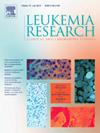HTLV-1持续感染和肿瘤发生的策略:免疫逃避和克隆扩增
IF 2.1
4区 医学
Q3 HEMATOLOGY
引用次数: 0
摘要
成人t细胞白血病淋巴瘤(Adult T-cell leukemia-lymphoma, ATL)是由人t细胞白血病病毒I型(HTLV-1)诱发的最严重的恶性t细胞白血病/淋巴瘤之一。HTLV-1通过增殖被感染细胞和逃避宿主免疫的策略在宿主体内持续存在。HTLV-1编码两种病毒致癌基因,tax和HTLV-1 bZIP因子(HBZ),它们与保护细胞死亡和促进细胞增殖有关。此外,HBZ和宿主基因的体细胞突变,如C-C趋化因子受体4 (CCR4)和CIC,将htlv -1感染的细胞转化为调节性T (Treg)样细胞,导致逃避宿主免疫。最近的一项研究揭示了htlv -1感染细胞克隆扩增的关键机制;HBZ激活转化生长因子(TGF)-β信号通路,不仅通过Foxp3的表达将htlv -1感染的细胞转化为treg样细胞,而且有助于htlv -1感染细胞自身的增殖。由于HTLV-1感染诱导的长寿,在感染的克隆中积累体细胞突变和表观遗传畸变,促进ATL的癌变。总的来说,HTLV-1的持续感染策略使感染细胞能够长期存活,最终通过遗传/表观遗传异常的积累导致ATL肿瘤发生。本文章由计算机程序翻译,如有差异,请以英文原文为准。
Stratagems of HTLV-1 for persistent infection and the resultant oncogenesis: Immune evasion and clonal expansion
Adult T-cell leukemia-lymphoma (ATL) is one of the most severe malignant T-cell leukemia/lymphomas induced by human T-cell leukemia virus type I (HTLV-1). HTLV-1 persists in the host through stratagems of proliferating infected cells and evading host immunity. HTLV-1 encodes two viral oncogenes, tax and HTLV-1 bZIP factor (HBZ), which are related with protection from cell death and promotion of cell proliferation. In addition, HBZ and the somatic mutations in host genes, such as C-C chemokine receptor 4 (CCR4) and CIC, convert HTLV-1–infected cells into regulatory T (Treg)-like cells, leading to evasion of host immunity. A recent study demonstrated the key mechanisms for clonal expansion of HTLV-1–infected cells; the activation of the transforming growth factor (TGF)-β signaling pathway by HBZ not only converts HTLV-1–infected cells into a Treg-like cells through Foxp3 expression, but also contributes to the proliferation of HTLV-1–infected cells themselves. Due to the longevity induced by HTLV-1 infection, somatic mutations and epigenetic aberrations are accumulated in infected clones, contributing to the oncogenesis of ATL. Collectively, the long-term survival of infected cells enabled by the HTLV-1’s stratagems for persistent infection ultimately leads to ATL oncogenesis via the accumulation of genetic/epigenetic abnormalities.
求助全文
通过发布文献求助,成功后即可免费获取论文全文。
去求助
来源期刊

Leukemia research
医学-血液学
CiteScore
4.00
自引率
3.70%
发文量
259
审稿时长
1 months
期刊介绍:
Leukemia Research an international journal which brings comprehensive and current information to all health care professionals involved in basic and applied clinical research in hematological malignancies. The editors encourage the submission of articles relevant to hematological malignancies. The Journal scope includes reporting studies of cellular and molecular biology, genetics, immunology, epidemiology, clinical evaluation, and therapy of these diseases.
 求助内容:
求助内容: 应助结果提醒方式:
应助结果提醒方式:


